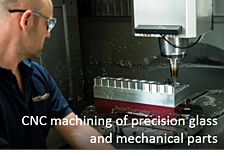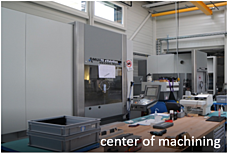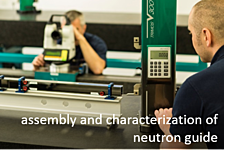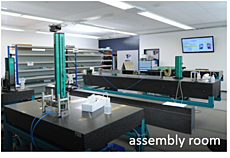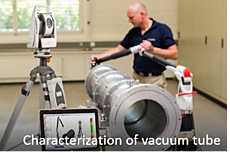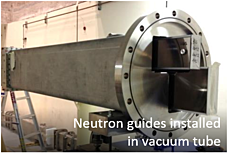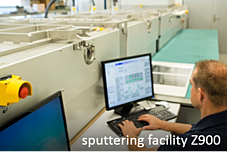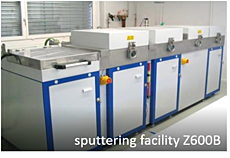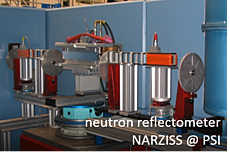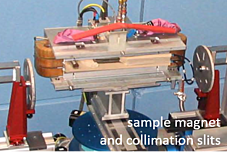our facilities

The production of high quality and long-living neutron guides requires excellent and modern equipment. We acquired machines and instrumentation to perform and control all the processes for the development and fabrication of sophisticated neutron optics: simulation, design, machining, sputtering, assembly, alignment, and of course comprehensive quality assurance.
engineering design / project management
- 3D-CAD workstations
- Software: Inventor 2015, we also handle most other software (Solid Works, Autocad, etc.)
- electronic project data management
fabrication
- two CNC grinding/milling machines
- calibration stage for milling tools
- mechanical workshop (lathe, milling and drilling machines for metal work)
- inline sputtering plant Z600B and Z900 at Klingnau
- contractual access to sputtering plants Z600A and TIPSI at PSI
- high accuracy granite alignment tables
characterization / quality control
- own neutron beam line NARZISS at SINQ
- X-ray facility (Siemens) for powder diffraction and reflectometry
- atomic force microscope
- optical equipment for alignment of guides and guide elements
- 3 Leica theodolites
- 1 Leica laser tracker
- 1 Romer measuring arm
- high precision dimension measurement instruments
- Priority access to the neutron reflectometer NARZISS @ SINQ
- access to neutron reflectometers MORPHEUS and AMOR at SINQ
- access to magnetometry
- access to interferometry for surface characterization
center for machining
The core equipment in our center for machining are two high precision CNC grinding machines. Their main features are:
- machining of glass, metals and other materials
- high precision machining
- specially developed plugs to fix samples
- CNC enables for machining arbitrary geometries, e.g. for non-linear focusing devices
- additional equipment for calibration of machines and tools
Further, regular lathe, milling and drilling machines are installed, e.g. for the preparation of dedicated tools for the assistance of our fabrication processes.
assembly
The assembly of neutron guides and other optical components is performed in our dedicated laboratory. For assembly and inspections of the assembled components the lab is equipped with:
- 2 work stations for guide assembly and waviness measurements
- various high precision dimension measurement instruments for guide assembly, dimensional inspections, etc.
- instruments are connected to PCs for automated data processing
- various high precision granite tables for assembly
- various specially developed tools for guide assembly, handling, installation and alignment
- laser tracker for 3D inspections and characterization of components being installed at customers site
- calibration tools to gauge the instruments frequently
- helium leak tester to measure leakage rates of vacuum assemblies, e.g. neutron guides, casings, etc.
Guide installation / 3d metrology
SwissNeutronics employs 3d metrology for the installation and alignment of neutron guides using most modern equipment. A dedicated process is developed for a most accurate alignment. In addition, comprehensive inspections of the neutron guide components are included probing the conformity with the design. A detailed documentation is provided at the same time.
Instruments:
- laser tracker Leica At402
- 3d measurement arm ROMER Absolute 7525
- theodolite Leica TM6100A
3d metrology for neutron guide installation:
- laser tracker & 3d measurement arm assisted
- improved accuracy of guide alignment
- handling complex alignments, e.g. in high radiation areas
- fully compatibility with CAD data
- detailed validation before delivery
- characterization (in lab) for installation (on-site)
- full documentation
- long-term monitoring of alignment possible
sputtering
Supermirror coatings at SwissNeutronics are produced using DC magnetron sputtering. SwissNeutronics operates two sputtering plants: i) Z600B and ii) Z900. The Z600B is a retrofit of the Leybold Z600 with extended capabilities. The name Z600B is with reference to the identical sputtering plant at PSI (Z600A), which was the origin of the foundation of SwissNeutronics. In 2011 SwissNeutronics installed the second DC magnetron sputtering facility Z900 for large area coatings.
Both systems use a completely oil-free pumping system, an improved transport system for the substrates, and an extended surveillance system that monitors the machine parameters during each production run. This way, plasma instabilities and mechanical instabilities of the plant are immediately spotted. All processes of the deposition are computer controlled starting with the lock in of the substrates into the deposition chamber. This ensures that all depositions occur at identical conditions enabling a high reproducibility of the coatings.
The main features are:
- capabilities for various targets
- extended surveillance system – including a sputter gas monitor
- oil-free pumping system
- large deposition area: with high homogeneity of layer thickness and growth
- processing of deposition completely computer controlled – including data storage of process monitoring
| Z900 | Z600B | |
|---|---|---|
| coating area | 502 mm x 1100 mm | 420 mm x 540 mm |
| magnetrons | 4 | 3 |
| base vacuum | 2 x 10-7 mbar | 2 x 10-7 mbar |
| layer thickness | accuracy & homogeneity: ±0.5% range: nano- to mircometer | |
| process control | completely computer controlled, extended surveillance system | |
neutron reflectometer NARZISS at SINQ, PSI
The instrument NARZISS is dedicated for testing neutron optical components, in particular for reflectivity measurements of neutron mirrors. It was built in close collaboration (as a combined effort) between the Paul Scherrer Institute (PSI) and SwissNeutronics. NARZISS is located in the neutron guide hall of the Swiss Intense Neutron Source SINQ (Quelle = source). A graphite crystal deflects neutrons out of the neutron guide and supplies a monochromatic beam with a wavelength of 0.5 nm to the instrument. A subsequent multilayer wavelength filter suppresses higher harmonics.
NARZISS measures the neutron reflectivity in an angle dispersive mode. The incident, monochromatic beam is collimated by means of two diaphragms. The identical installation exists for the exit beam. This configuration enables unpolarized reflectometry investigations.
Moreover, NARZISS is equipped to perform polarized reflectivity measurements with full polarization analysis. A remanent transmission polarizer and analyzer (mirrors) serve for this purpose. Neutron beam polarization and the polarity of the analyzer are flipped by switching the magnetization of the transmission mirrors with a short magnetic field pulse. During the measurements only a small guide field is applied. An electro magnet at the sample stage provides magnetic fields up to 1000 G. Additionally it is possible to operate the sample magnet at inverse polarity in order to prepare the magnetization of samples to any desired state of their hysteresis.
In summary, NARZISS has the following characteristics and features:
- angle dispersive operation mode
- wavelength: 0.5 nm
- typical collimation: 0.1°
- provisions for beam polarization and polarization analysis - remanent Fe/Si supermirror in transmission (flipping ratio ≈140)
- sample magnet: -1000 G < H < +1000 G

